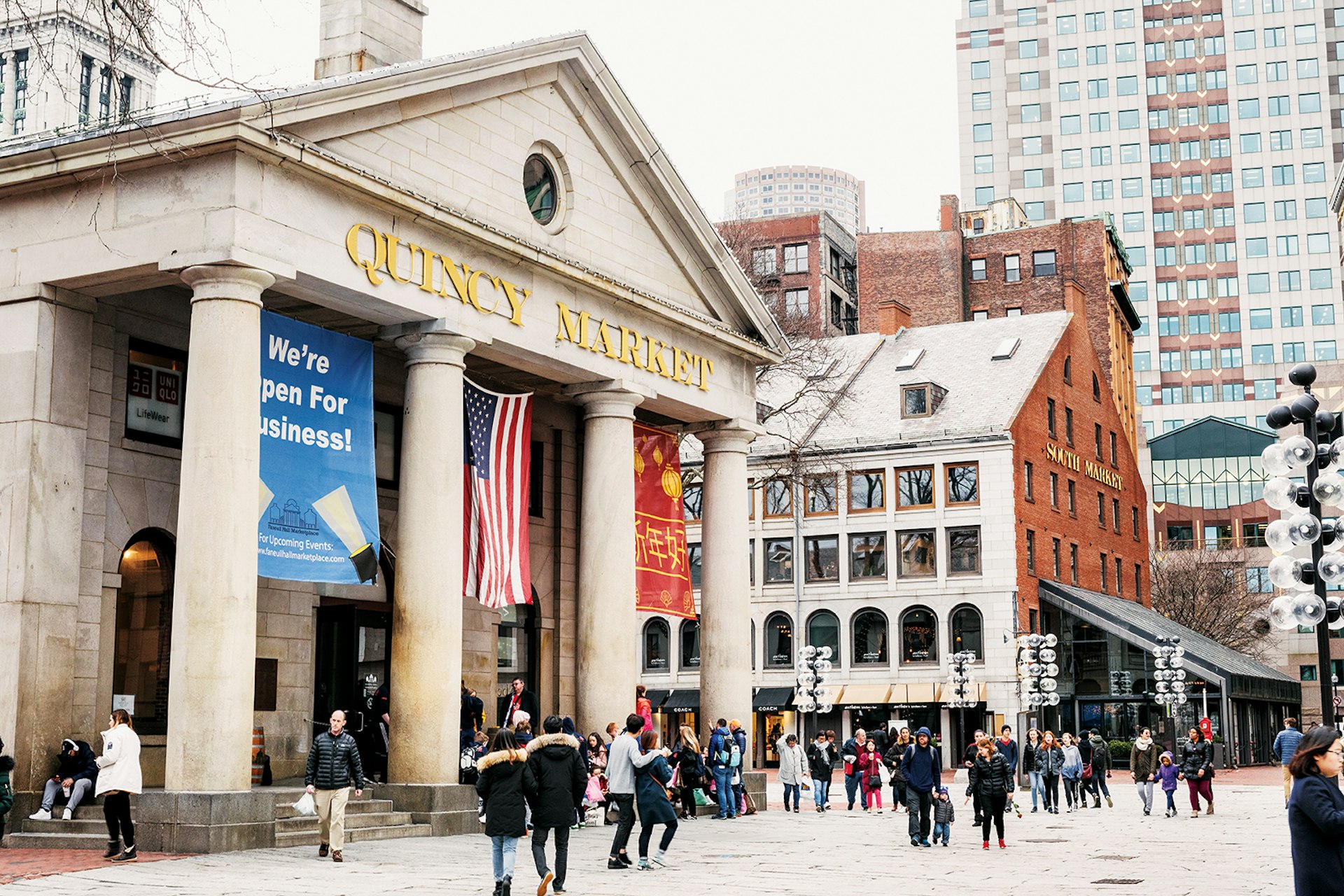From colonial fishing ships to presidential inaugurations, we trace the origins of Boston’s signature dish, New England clam chowder, and go on a quest for a bowl of the city’s best.

Clam chowder: the origin story
When it comes to identifying what goes into the ideal bowl of clam chowder, personal preferences vary, but one good historical reference point comes from Herman Melville’s classic 1851 novel, Moby-Dick, whose protagonist, Ishmael, visits a fictional chowder establishment on the island of Nantucket, off the coast of Massachusetts.
“Oh, sweet friends! Hearken to me. It was made of small juicy clams, scarcely bigger than hazel nuts, mixed with pounded ship biscuit, and salted pork cut up into little flakes; the whole enriched with butter, and plentifully seasoned with pepper and salt.”
Toss some potatoes and onions into Melville’s ancient recipe and substitute cream for butter, and you’ve got the makings of a fine New England clam chowder. The signature dish of the region, clam chowder has been served at presidential inaugurations since 1981, and is ladled out by the ton every year to tourists and locals alike.
To learn more, I’m in Boston, a city steeped in colonial history that surely holds answers to my questions about chowder’s centuries-old origins. As I cross a bridge over Boston Harbor, I pass the Boston Tea Party Ships & Museum, a tribute to the colonists who dumped British tea into the harbor and helped ignite the American Revolution. Looming behind it on the horizon are tall glass buildings, a mixture of luxury apartments and offices that have sprung up in the past decade. I settle into a seat at Legal Sea Foods, where I have a perfect view of the Boston Fish Pier. Recently given a spot on the National Register of Historic Places, the pier opened in 1914 and was a major base for the fishing industry by 1920. Today it still processes thousands of pounds of seafood a day, including some of the clams that go into the city’s chowder. Beyond a 360-degree metallic bar, Legal's cooks are hard at work in the open kitchen. The smell of fried fish wafts over a busy lunchtime crowd.

Sitting across from me is executive chef Rich Vellante, who has learned a thing or two about the history of chowder during his 20 years at the restaurant. Vellante tells me that New England clam chowder’s origins can be traced back to colonial times, when fishermen from England, France and Nova Scotia went in search of fortune on the high seas. The dish’s origin wasn’t necessarily a country extending its culinary footprint. Rather, it was a dish born of necessity. Onions, potatoes and salt pork all were kept on board, while clams and milk were plentiful on shore. With a lack of refrigeration, the best choice for sailors was to throw everything into a big pot and make a stew.
For Vellante, who has lived in the area most of his life, the dish evokes nostalgic memories of New England's seafood past.
“The combination of the briny clams, the richness, the sweetness of the cream, the salt pork, is something that’s just so nurturing,” he says. “Whenever you’re around a cup or bowl of chowder, it’s like home.”
Here, chowder is served in a white ceramic bowl with a bag of oyster crackers on the side. The clams are chewy and sweet, but not saccharine, and the potatoes offer a deliciously starchy balance in texture.
There’s an aromatic, herbal flavor I can’t quite put my finger on, but Vellante is understandably protective of the chowder’s precise recipe, a secret less than a handful of people know. “It’s like the Coca-Cola recipe,” he says. “It’s our recipe, one that we love, so there are a few things we don’t share about it.”

Trying a trio of chowders at Quincy Market
Later that day, I visit Quincy Market, a historic building in the heart of downtown, where chowders are plentiful. Opened in 1826 as a meat and produce market, it now houses around 30 culinary merchants separated by white columns in Greek Revival architectural style. As I walk through the colonnade, workers at kiosks that serve pizza (Regina Pizzeria), hot dogs (The Dog House) and chocolate chip cookies (The Boston Chipyard) hawk samples or call out to potential customers among the tourist-heavy crowd.
Despite the historic setting, the restaurants are thoroughly modern in their catering. At Fisherman’s Net, manager George Maherakis, who runs the stand with his father, Kostas, tells me they serve the only gluten-free chowder at Quincy Market. They don’t use pork, either. “The authentic, 100 percent New England way would be with pork,” George admits, “but all the restaurants in here try not to use it, because a lot of people don’t eat bacon.”
Of the trio of chowders I sample at Quincy Market, theirs is the best: a hearty chowder that doesn’t cross the line into an overwhelming sauce-like thickness that makes you painfully aware of how much double cream goes into every steaming bowl.
More steps to chowder nirvana
Over the next two days, I try a bevy of chowders. At Atlantic Fish Co, I sit in a window seat surrounded by model ships, trying to figure out how best to eat the bread bowl my chowder is served in, while an elderly couple looks on with a mix of curiosity and disapproval. At the crowded Yankee Lobster Co, I pair my chowder with a big basket of fries, as an arriving woman tells her three friends she is “literally obsessed” with the restaurant’s chowder, while not so subtly eyeing mine.
Almost every spot I visit does a decent job with the dish, but the quest for a “perfect” chowder eludes me. I begin to feel like Goldilocks, finding imprecise flaws in every bowl. This chowder is too thick. This one is too thin. This one is too grainy. This one has clams that are too chewy.

During a fact-finding mission to Boston Public Market, I get a tip from Ryan Rasys, a sales manager at Red’s Best, a seafood retailer and wholesaler. Row 34, another Seaport spot I missed earlier in the weekend, is known for having some of the best oysters in the region. After tasting some of the chowder from Red’s Best (a lighter broth with a noticeable garlic kick), I’m inclined to trust Rasys’ taste.
With my journey’s end in sight, I head out, ready to cross the harbor one more time. It’s brunch hour at Row 34, and groups of twenty-somethings are chattering at the tables and bars. I’m greeted by owner/chef Jeremy Sewall, who leads me to a quiet corner of the restaurant. When asked what makes a great dish, Sewall says, “To make a really good chowder, you have to stick to the core values of what chowder is. Salty, fishy, dairy, potatoes, onions, all of those things. That’s where you have to start and you can’t go too far away from that.”

When I dig into Row 34’s chowder, I know I’ve finally found my chowder nirvana. Filled with just the right number of clams, it has a few accents I haven’t encountered elsewhere. Row 34’s chowder comes with a house-made cracker that crumbles nicely, but doesn’t dissolve into nothingness. The potatoes are red instead of white, with the skin still on them. The broth is a little less heavy, possibly because the restaurant uses half cream and half milk, instead of double cream. Per Sewall’s recommendation, I pop in a few dabs of hot sauce, which adds a subtle but unmistakable heat.
When Ishmael and friend Queequeg finish their chowder-filled meal in Moby-Dick and ready themselves for bed, an innkeeper asks them whether they prefer cod or clam chowder for breakfast the next day. “Both,” answers Ishmael, “and let’s have a couple of smoked herring by way of variety.”
Leaning back to digest and savor the meal, I’m inclined to think Melville was on to something.
This article originally appeared in the Summer 2018 issue of Lonely Planet magazine.











